The helmeted guineafowl, commonly known as the tarentaal in South Africa, is a bird to marvel at. This game species is one of Africa’s famous spotted animals.
They are unmistakable with their black and white dotted bodies, colorful faces, and a dinosaur horn-like casque on their heads.
These scrubland-loving savanna birds are members of the guinea fowl family, Numida meleagris. The helmeted guineafowl goes by many names in Southern Africa, including impangele chicken and tarentaal birds.
Guineafowls spend their day scratching around and enjoy taking the odd dust bath before a midday snooze. Generally, they hang out in large groups making raucous chatter sounds and loud calls.
Here are some fun helmeted guinea fowl facts to learn more about these intriguing birds with horns.
14 Facts About the Impangele Bird (Helmeted Guinea Fowl)
Did you know that the group name for guinea fowls is a confusion? When there is a slight noise, they scurry around, flap their wings with a somewhat confused expression, and display peculiar behaviors.
These wild African chicken-like birds are quite fascinating with their numerous quirky traits. So without further ado, let’s look at some interesting things to know about the helmeted guineafowl.
1. This chicken coquena bird species is monomorphic
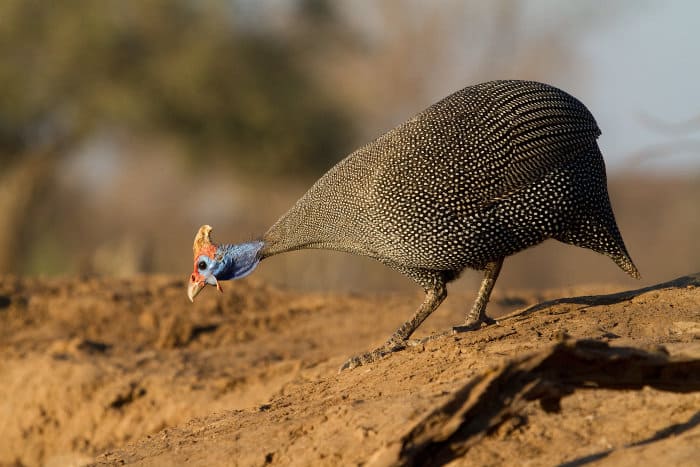
The male and female helmeted guineafowl both look and act alike. This means they are monomorphic and monochromatic. They can be rather comical and enjoy looking at their reflections.
The helmeted guineafowl’s body size is similar to that of chickens. It reaches approximately 58 to 64 cm in length and can weigh up to 1.8 kg.
While they may not be the most beautiful African bird, the guineafowl’s appearance is rather unique. Their bodies feature an almost ‘bead-like‘ design. This consists of dark gray feathers and tiny white dots.
These birds also have a red-colored ‘wattle‘ on either side of their short beaks. Their bald faces and necks consist of blue-colored skin. They have an orange or brown helmet cap on their featherless heads.
2. They choose to walk – even though they can fly
Guineafowls are terrestrial birds and spend most of their time scavenging the grounds. They predominantly choose to keep their feet planted on the earth and can walk up to 10 km a day.
Can guinea fowls fly? Their wings work fine, but they only fly when in danger or to get up to their communal roosts in the trees at dusk. Their flights are usually short, covering around 120 meters before landing.
3. They’re rather chatty

The helmeted guineafowl has a personality of its own. When disturbed, they have a distinct noisy and loud call. They often become lunatics, charging around and crying out to one another.
Their alarm call often sounds like long and short stutters. It sounds similar to “chuk-chuk-chuk-chukaaa” or “kek-kek-kek-kraaaaaaaah”.
When the flock is together, individuals communicate using a low-pitched “Kerr” or “chuk” sound.
The African guinea fowl makes different sounds according to the occasion. It differs during the breeding season compared to the sound they make when in danger.
While the tarentaal sound isn’t one of the most popular safari sounds in Africa, it will certainly catch your attention.
4. They make for great “watchdogs”
The ancient Romans first domesticated guineafowl. They were mainly used for their meat, eggs, and tick control. But they were also used as ‘watchdogs’ because of their alarming cry when disturbed.
Today, humans keep these birds domestically and with other fowls to ward off predators.
Helmeted guineafowls establish their homes around farms, residential areas, and the bushveld.
Their overall population is stable, and in no danger, so you can expect to see many wandering guinea fowl in South Africa.
5. They’re mainly found south of the Sahara

Helmeted guineafowls are endemic to Africa. While these fowls roam around any type of habitat, they prefer grasslands, agricultural land, thorn, and bushveld. They mostly avoid arid areas and rainforests.
These communal birds live in large flocks. They walk through the bushveld in a single file and imitate the dominant leader.
The birds are not migratory. However, they do move around much more during the breeding season. This is when they are most active.
6. They are omnivorous game birds
The helmeted guinea fowl has an omnivorous diet and forages for food. They are opportunistic eaters, enjoying variety in their diets.
Their dinner menus mostly consist of seeds, reptiles, berries, spiders, snails, roots, grains, and insects. Just like chickens, they use their short beaks and feet to scratch up soils and rubble in search of food.
These African chicken birds are well-known for keeping control of tick and grasshopper populations.
They often follow after troops of monkeys for fallen fruits. Their feeding times are mostly in the early mornings and late afternoons.
7. They are quite the athletes

South African guinea fowl are social birds, flocking together in large communities.
Males dominate and settle their differences by chasing after one another. In the end, the male with the best endurance is the dominant alpha.
During combat, the males make themselves appear larger by puffing up their feathers and lifting their wings.
8. Do guinea fowls mate for life? Yes!
Guineafowls are monogamous, and couples mate for life. The guinea fowl breeding season in South Africa is from October to April.
During this time, partners will perform a ‘duet’ together, singing simultaneously.
The males fight aggressively to impress guinea fowl females. They challenge mostly terrestrially, often choosing to run rather than fly.
9. They hide their eggs well

Guineafowls are ‘seasonal’ layers. The nests are shallow and made by nestling in the ground, well-concealed by thick grass, sticks, and feathers.
Their eggs have a hard shell and are a bit smaller than that of your average chicken egg.
In season, the African guinea hen may lay an egg a day until they have a clutch of around 7 to 30 eggs. The incubation period is around 26 to 28 days.
10. Dads are important in raising the young
Baby guineafowls are called keets. One of the most interesting facts about guinea fowl families is the relationship between the keets and their father.
Before incubation, males will guard the eggs and leave as soon as the incubation period starts. Once the eggs have hatched, they return. The male plays a significant role in teaching the keets what to eat.
Guineafowls reach sexual maturity around two years of age. They have a life expectancy of up to 15 years.
11. Some females dump their eggs
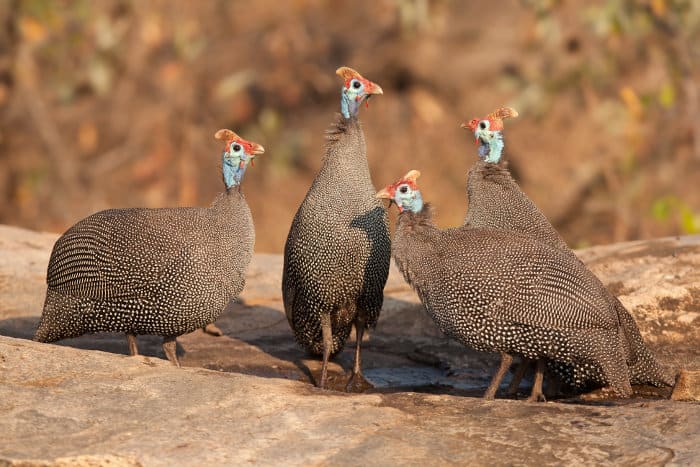
In some cases, females will lay their eggs in another guineafowl’s nest. They do this so that the owner of the nest will incubate them. This rather lazy act is known as egg-dumping.
12. This coquena bird has many relatives
Guineafowl, of the Numididae family, comprises several wild guinea fowl species. These include the helmeted guineafowl and the crested guineafowl. Both species occur throughout Sub-Saharan Africa.
Other relatives, such as the plumed, crested, vulturine, and white-breasted guineafowl, inhabit parts of Central, Sub-Saharan, Northeast, and Western Africa.
13. They have a large number of predators
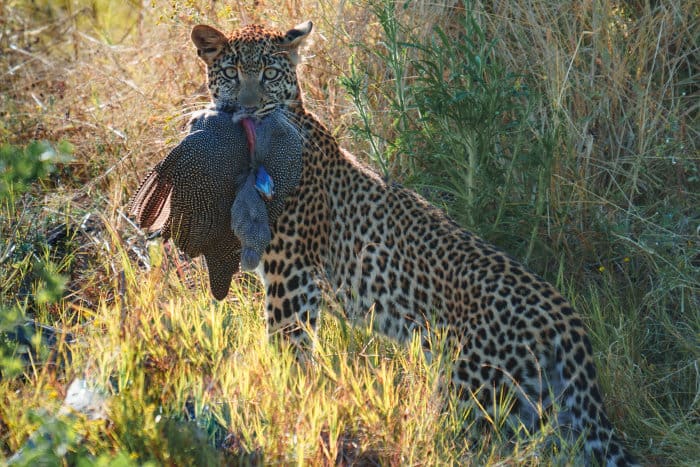
Wild flocks of helmeted guineafowl have many predators. Domestic dogs and cats catch a fair number of their population.
Some farmers kill them because they damage their crops, and birds of prey, including large African eagles and owls, hunt them.
14. Helmeted guinea fowls are not the best pets
These African chicken animals do not make the greatest of pets. Unlike other domestic breeds of fowl and their pheasant relatives, helmeted guineafowls are not the cuddliest.
If you keep them captive in a residential area, their loud sounds when agitated may not be ideal for a nearby neighbor.
African Guinea Fowls Have Made Their Mark

These gorgeous African guinea birds have certainly made their mark. With their loud crackling alarm cry and adorable body art, what is not to love about these impressive ‘watch dogs’?
When it comes to the sounds of a guinea fowl, South Africa’s bushveld would not be the same without the unmelodious calls from these terrestrial birds.
Why not see them for yourself? Plan your safari trip to spot these wondrous animals and other safari birds in their natural environment.
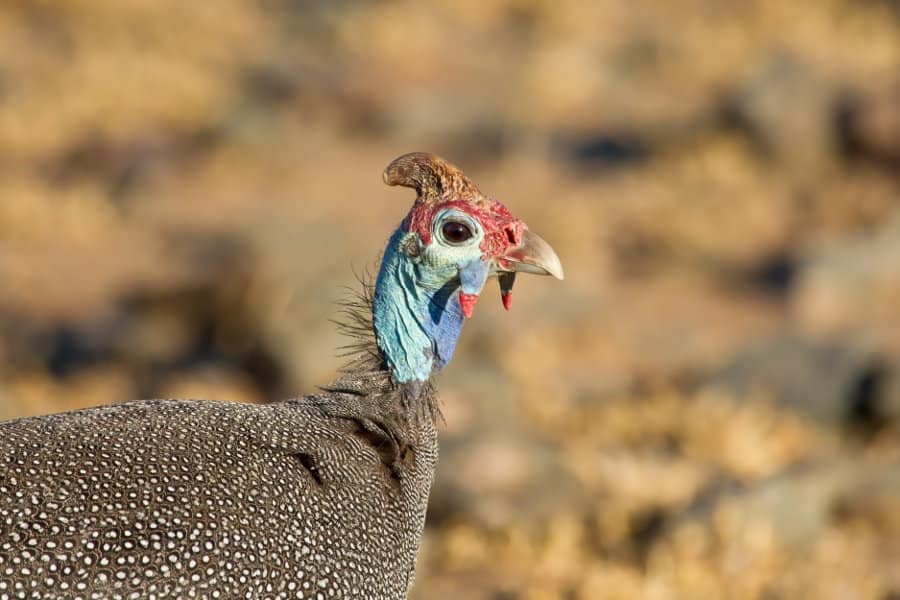
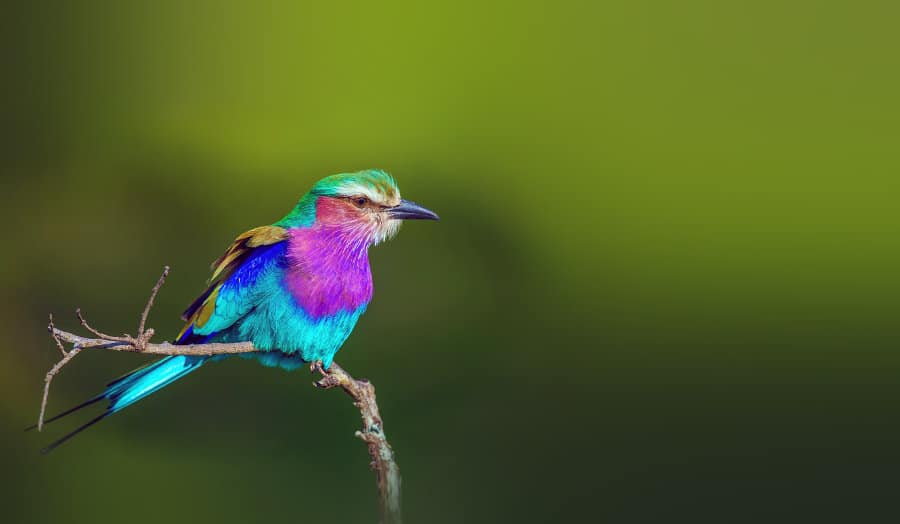

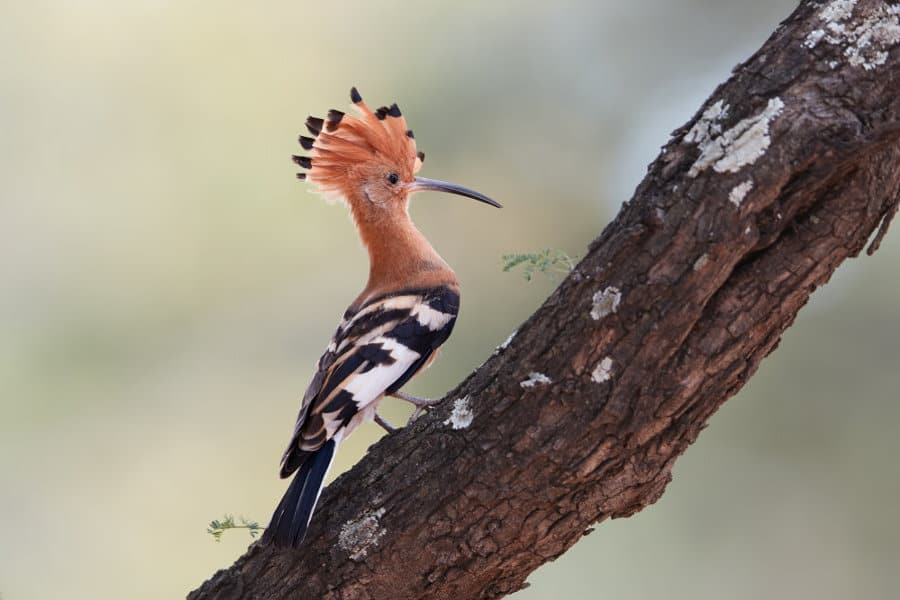
Brilliant job at breaking down this interesting species. Well done. I am a specialist guide and found the way of explanation to be very very informative. Well done.